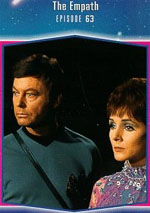
STAR TREK:
THE ORIGINAL SERIES:
Season Three:
|
Elaan of Troyius(Star Trek story #57 in production order)written & directed by John Meredith Lucas I couldn't go through Star Trek's unfairly dismissed third season without saying a few words about this episode. Outgoing producer John Meredith Lucas gets a rare opportunity here to both write and direct, and thus see a vision for the show all the way through. The main plotline of a spoilt young ruler and her fixed marriage is fairly well done, providing the actors, Shatner in particular, with many emotional and humorous moments throughout, as well as providing thought-stimulating dilemmas without easy answers. In this respect, it begins to resemble the longer-lasting Star Trek the Next Generation series in a good way.
And Fred Steiner is back composing new music for the show. While the score generally has a lighter and less-important sound than his typical first and second season efforts, the Klingon battle sequences near the end get some electronically enhanced, thumping faced-paced cues of better length than the "Charlie-X" cues often shoe-horned to fit similar bills in previous episodes. Very cool! This seems to me to have been the perfect episode to use as the season opener, proudly displaying Season Three's greater capacity for model work as well as its much lamer & cheaper excuse for hand-phaser fire. But instead they went for "Spock's Brain", an episode that many fans regard as the worst ever of Trek. Go figure. So watch this one at least in production order. It works so much better!
McCoy does ask Spock if they should approach the local community to try to communicate what they know, and Spock decides it would be a wasted effort since they probably wouldn't understand. Maybe they would have since they actually do know about it in their own way, and they might have been able to point the Enterprise crew to a quicker and easier solution. But Spock strikes a good balance, neither advertising his version of events to the locals, nor expending energy to try to hide it from them. Kirk probably does get more involved than the Prime Directive would recommend, but he doesn't remember a thing about any of Starfleet's laws when doing so. In fact, with his memory loss preventing him from divulging any of his culture's worst secrets anyway, the Prime Directive becomes a moot consideration. The episode could easily have led to further developments later on in the series, but that portion of the ending is a predictable bit of a cop-out, maintaining the sixties style of returning all the regular characters to their starting positions so that all episodes can be shuffled interchangeably. Swell. All is not lost, as there is plenty of staple action, suspense, excellent model work, and decent visual beam effects all the way, providing the story many good beats and scenes including a dramatically satisfying climax. Gerald Fried does an enjoyable and tasteful job creating new music for the episode, while also reworking into it some of his prior themes like the lighter tribal woodwinds from "Friday's Child" (production #32), and Spock's moody cues from "Amok Time" (production #34). In fact, Spock's cues seem more polished and less raw than they did back in season two, another nice notch on season three's belt. All in all, season three has yet another winner, and makes a very unique and enjoyable contribution to the Star Trek canon. Nice.
While this episode does have its moments, including the rarity for television of many finely acted and executed dialogue-less emotional scenes, and our Star Trek trio remain expertly engaging in their explorations, "The Empath" must take a huge hit for relying on the most boring external "A" plot ever to be overused by science fiction: the capture and escape routine that is stretched out to last the entire hour (or more). Ideas and characters that might have been engaging in their natural habitats when surrounded by the usual complexities take a turn for the clinical when isolated on an empty black stage with no walls and a dearth of character and situation to interact with. In this non-environment, any messages or morals attempted to be conveyed to the audience end up having all the subtlety of a sledgehammer, and aren't any fun at all. Perhaps the biggest hole of plot-logic is in the absence of Gem's "competitors". The supposed real reason that the Vyans test Gem is not so much to determine her people's worthiness on its own merits, but more to see if it is greater than that of some other planet in the system, because they can only transport one civilization to safety. Dumb, dumb, dumb. It all boils down to nastiness generated by competition over limited resources.... I think I've heard that one before. And that analysis suggests to me that the inspired solution is to expand one's awareness and view of resources - perhaps initiating good relations with the Federation can bear the fruit of having them save one civilization while the Vyans save the other? Or if the Federation can't handle it, perhaps another civilization that they have met on their explorations would be willing and able? Networking might be a good idea..... Ah, well. It seems this episode's writer is more interested in limited sacrificial ideas. Ho hum. That established, just where is the representative of those other one or two civilizations that the Vyans might save instead of Gem's?? Their absence makes the episode feel that much more contrived and unreal. "The Empath" remains an interesting episode to view once, but shows that original Star Trek was beginning to become tired in its approach.
Secondly, and this perhaps indicates the decline of quality in Star Trek's third season, the entire drive to keep the populace ignorant is fueled by the "Oracle" character. Despite a host of social customs and technological devices used as mechanisms for this control, there is never any reason given as to why the Oracle would want its people to be kept ignorant. Gene Roddenberry's criticism of other science fiction series: "not enough characterization, not enough motivation" certainly applies here. There are a lot of good ideas in this piece, which are not developed fully. Jon Lormer's old man character gives the definitive poetic rendition of the premise's riddle, yet the effort he expended to discover his secret in the first place is undermined by the ease with which the Enterprise trio and the local guards meet on the surface near the beginning. What we don't have is the kind of inverted view of living on the hollow inside of a sphere, where the supposed sky is in the center of the ball, and "descending" actually leads you outside into space. This makes the exterior set look like just another hum-drum stock Star Trek planet with the art director choosing a red gel for lighting the sky this week. Dr. McCoy also has some interesting character challenges this episode, but they do feel contrived, and he predictably comes back to his starting position before the episode is over, nullifying any possibility of a continuing character arc. Not that this was a great direction for his character to go through in the first place. And so another episode of great ideas turns out to be somewhat mediocre. Not to fear, for season three has better stuff still in store....
These Season Three prime directive stories are available on DVD and Blu-Ray. Click on the Amazon symbol for the desired disc format and location nearest you for pricing and availability:
Reviews written by Martin Izsak. Comments on this article are welcome. You may contact the author from this page:
|
||||||||||||||||||||||||||||||||||||||||||||||||||||||||||
|
| |||||||||||||||||||||||||||||||||||||||||||||||||||||||||||

LYRATEK.COM |
|
||||||||||||||||||||||||||||||||||||||||||||||||||||||||||

















